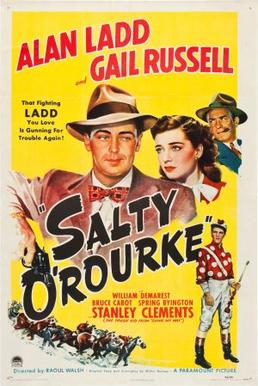Robert Florey was a French-American director, screenwriter, film journalist and actor.

Anne Baxter was an American actress, star of Hollywood films, Broadway productions, and television series. She won an Academy Award and a Golden Globe, and was nominated for an Emmy.

Enos Edward "Yakima" Canutt was an American champion rodeo rider, actor, stuntman, and action director. He developed many stunts for films and the techniques and technology to protect stuntmen in performing them.

George Francis "Gabby" Hayes was an American actor. He began as something of a leading man and a character player, but he was best known for his numerous appearances in B-Western film series as the bewhiskered, cantankerous, but ever-loyal and brave comic sidekick of the cowboy stars William Boyd, Roy Rogers and John Wayne.

Sidney Alderman Blackmer was an American Broadway and film actor active between 1914 and 1971, usually in major supporting roles.

Suzanne Kaaren was an American B-movie actress and dancer who starred in stock film genres of the 1930s and 1940s: horror films, westerns, comedies, and romances.

John Brown was an American college football player and film actor billed as John Mack Brown at the height of his screen career. He acted and starred mainly in Western films.

Kenneth Olin Maynard was an American actor and producer. He was mostly active from the 1920s to the 1940s and considered one of the biggest Western stars in Hollywood.

Sam Katzman was an American film producer and director. Katzman's specialty was producing low-budget genre films, including serials, which had disproportionately high returns for the studios and his financial backers.

Marjorie Burnet Rambeau was an American film and stage actress. She began her stage career at age 12, and appeared in several silent films before debuting in her first sound film, Her Man (1930). She was twice nominated for the Academy Award for Best Supporting Actress for her roles in Primrose Path (1940) and Torch Song (1953), and received the 1955 National Board of Review Award for Best Supporting Actress for her roles in A Man Called Peter and The View from Pompey's Head.

Don Barry, also known as Red Barry, was an American film and television actor. He was nicknamed "Red" after appearing as the first Red Ryder in the highly successful 1940 film Adventures of Red Ryder with Noah Beery Sr.; the character was played in later films by "Wild Bill" Elliott and Allan Lane. Barry went on to bigger budget films following Red Ryder, but none reached his previous level of success. He played Red Doyle in the 1964 Perry Mason episode "The Case of the Simple Simon".

Rod Cameron was a Canadian film and television actor whose career extended from the 1930s to the 1970s. He appeared in horror, war, action and science fiction movies, but is best remembered for his many Westerns.

Jasper Joseph Inman Kane was an American film director, film producer, film editor and screenwriter. He is best known for his extensive directorship and focus on Western films.
Lewis D. Collins was an American film director and occasional screenwriter. In his career spanning over 30 years, he churned out dozens of Westerns.
Pine-Thomas Productions was a prolific B-picture unit of Paramount Pictures from 1940–1957, producing 81 films. Co-producers William H. Pine and William C. Thomas were known as the "Dollar Bills" because none of their economically made films ever lost money. "We don't want to make million dollar pictures," they said. "We just want to make a million dollars."

Miss Susie Slagle's is a 1946 American drama film directed by John Berry. It was based on the popular novel by Augusta Tucker. The film was Berry's directorial debut and first starring role for Joan Caulfield.

Salty O'Rourke is a 1945 American sports drama film directed by Raoul Walsh and starring Alan Ladd, Gail Russell and William Demarest. Produced and distributed by Paramount Pictures, it was nominated for an Academy Award in 1946.

Abroad with Two Yanks is a 1944 American comedy film directed by Allan Dwan and starring Helen Walker, William Bendix and Dennis O'Keefe as the title characters. It was Bendix's third and final role in a film as a US Marine and the first of Dwan's three films about the United States Marine Corps.

Gypsy Wildcat is a 1944 Technicolor adventure film directed by Roy William Neil starring Maria Montez, Jon Hall and Peter Coe. It was co-written by James M. Cain.
Earl Felton (1909–1972) was an American screenwriter.


















